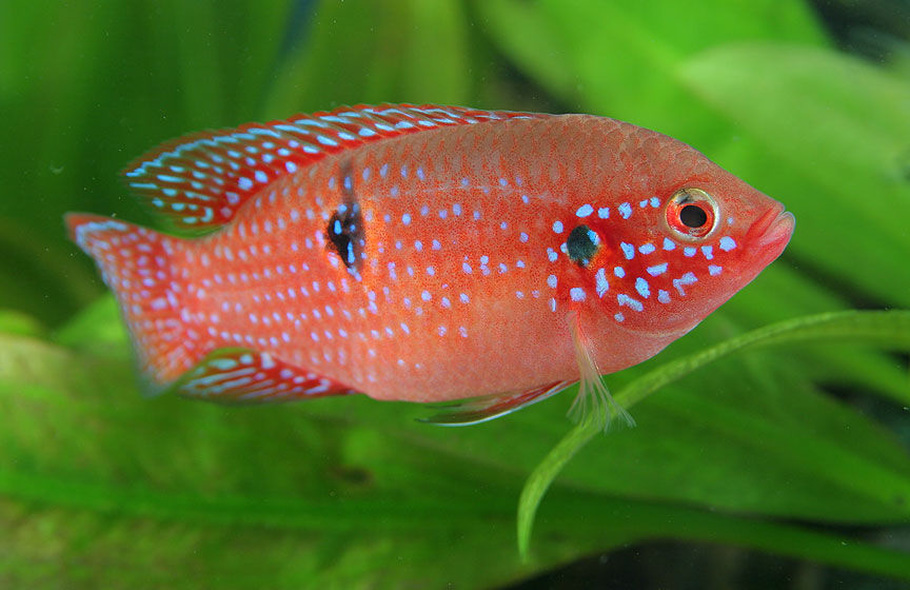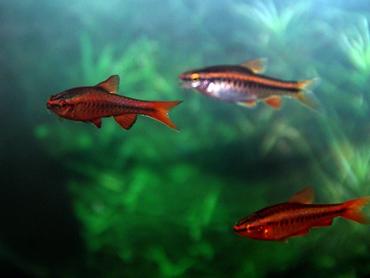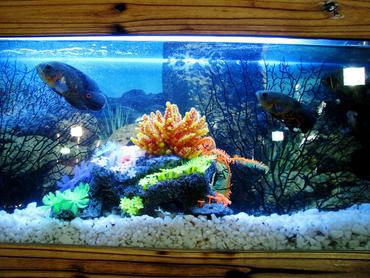JEWEL CICHLID SPECIES PROFILE

Updated
Jewel Cichlids are a group of brightly colored cichlids from Africa. These fish can be very colorful but they are often difficult to keep in the home tank due to their aggression.
You may already know that cichlids are some of the most colorful freshwater fish in the world and the jewel cichlid is the crown jewel. This species is aptly named for its bright coloration and sparkling appearance. These cichlids make a wonderful addition to the cichlid tank, but they can be a little bit tricky to care for at times.
If you want to be successful in keeping jewel cichlids in your tank at home, make sure you take the time to learn as much as you can about this beautiful species. In this article you will learn everything you need to know to keep these lovely fish including background information, nutritional information, and tank requirements.
Basics About Jewel Cichlids
The jewel cichlid is actually a genus of cichlids native to Africa. These species range from about 3 inches to nearly 12 inches in length, though they tend to be smaller in the home aquarium than in the wild. Most jewel cichlids are very brightly colored and their colors become even more intense during breeding. In addition to being more brightly colored than many cichlid species, jewel cichlids also sometimes have more pointed dorsal, ventral, and anal fins.
The jewel cichlid is actually a genus of cichlids native to Africa. These species range from about 3 inches to nearly 12 inches in length, though they tend to be smaller in the home aquarium than in the wild. Most jewel cichlids are very brightly colored and their colors become even more intense during breeding. In addition to being more brightly colored than many cichlid species, jewel cichlids also sometimes have more pointed dorsal, ventral, and anal fins.

Jewel cichlids can be a little bit difficult to care for, especially in the community tank, because some species have aggressive tendencies. These cichlids can be very territorial so you need to be careful about keeping them in a tank large enough that they can establish their own territory. If you add jewel cichlids to an already established tank, make sure you decorate it with some rocks and plants to break up sight lines and to reduce aggression. You should also be aware that jewel cichlids are avid fin nippers, especially if they are underfed. Keep this in mind when choosing tank mates for your jewel cichlids – you don’t want to pair them with species that have long flowing fins.
Tank Requirements for Jewel Cichlids
Jewel cichlids come from Africa where they tend to inhabit the muddy bottoms of rivers and streams. The size of the species you choose will determine the size of your tank, but you shouldn’t keep jewel cichlids in a tank smaller than 40 gallons – the only exception is a breeding tank. In order to keep your jewel cichlids healthy you want to mimic the conditions in their native environment as much as possible. While the details will vary according to species, most jewel cichlids prefer a pH between 6.5 and 7.5 and a temperature range between 74°F and 80°F.
In addition to thinking about the water parameters for your jewel cichlid tank, you also need to think about the decorations. Jewel cichlids do best in a tank that has plenty of caves and flat rocks that they can claim as their territory. Like many species, jewel cichlids have a tendency to dig in the substrate which can disturb live plants. There are, however, certain species of plants that tend to do well in jewel cichlid tanks – these include Amazon sword plants and various cryptocoryne species. Other plants may be okay if you protect the roots with stones or attach them to driftwood.
Nutritional Requirements for Jewel Cichlids
As is the case for many cichlids, jewel cichlids will eat just about anything you offer them. In order to maximize the coloration of your jewel cichlids, however, you should feed them a varied diet of live, frozen, freeze-dried, and pellet foods. Start with a staple diet of cichlid flakes or pellets and supplement it with various live and frozen foods. You can also offer your jewel cichlids fresh vegetables on occasion. The diet you offer your cichlids is especially important if you want to condition them for breeding. In this case, focus more on live and frozen foods.
Breeding Jewel Cichlids
Jewel cichlids make excellent parents – typically the male and female share the task of caring for their young once they have hatched. These fish usually spawn on a large flat surface and the eggs hatch 2 to 4 days later. Once the eggs hatch, the parents might move the fry to another, safer location until they become free-swimming. After the fry absorb what is left of their yolk sac you will need to start feeding them finely crushed flake food and mashed pellets. You generally do not have to worry about the parents eating the fry, but you should remove other fish from the tank just in case.
Jewel cichlids make excellent parents – typically the male and female share the task of caring for their young once they have hatched. These fish usually spawn on a large flat surface and the eggs hatch 2 to 4 days later. Once the eggs hatch, the parents might move the fry to another, safer location until they become free-swimming. After the fry absorb what is left of their yolk sac you will need to start feeding them finely crushed flake food and mashed pellets. You generally do not have to worry about the parents eating the fry, but you should remove other fish from the tank just in case.

In terms of breeding requirements, you need to condition your jewel cichlids for breeding with a healthy diet. Jewel cichlids are monogamous breeders so you should purchase a breeding pair or raise a group of juveniles together and wait for them to pair off naturally. Once you have conditioned your jewel cichlids for breeding and transferred them to a breeding tank you can try increasing the tank temperature by a degree or two to encourage spawning.
Jewel Cichlid Species
As you’ve already learned, jewel cichlids are actually a genus of cichlids native to Africa – there are eleven different species that belong to this genus. The species of jewel cichlid include:
- Hemichromis angolensis
- Hemichromis bimaculatus
- Hemichromis cerasogaster
- Hemichromis elongatus
- Hemichromis exsul
- Hemichromis fasciatus
- Hemichromis frempongi
- Hemichromis guttatus
- Hemichromis letourneuxi
- Hemichromis lifalili
- Hemichromis stellifer
Each species of jewel cichlid is unique and some of them are more readily available than others. Below you will find an overview of some of the jewel cichlid species that are recommended for the home aquarium.
- African Jewelfish (Hemichromis bimaculatus) – This species of jewel cichlid grows up to about 6 inches long and it has a red body with blue spots. These fish are native to West Africa and they require warm water and slightly acidic pH to thrive in the home aquarium. It is also important to note that this species can be very aggressive, especially during breeding, so they may not be a good choice for a community cichlid tank.
- Banded Jewelfish (Hemichromis fasciatus) – Also known as the five-spot cichlid, the banded jewelfish comes from West Africa where it can be found in the upper Zambezi River, the Nile Basin, and Lake Chad. This species grows to about 10 inches long and it has a yellow-green color with five large black patches along the side. These fish tend to do best in pairs and should be kept in a very large tank, at least 55 gallons.
- Blood-Red Jewel Cichlid (Hemichromis lifalili) – This is one of the most recognizable jewel cichlid species, known for its dark red coloration with rows of small blue spots. These fish grow up to 4 inches long and they tend to breed fairly easily in the home aquarium.
Hopefully by now you understand that jewel cichlids can be a joy to keep in the home aquarium, although they can be challenging as well. Use the information you’ve learned to cater your tank to the needs of your jewel cichlids to ensure that they remain happy and healthy.
comments powered by Disqus






































































































































